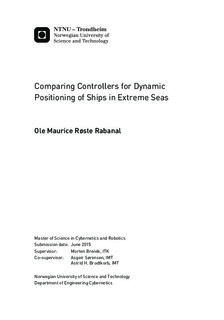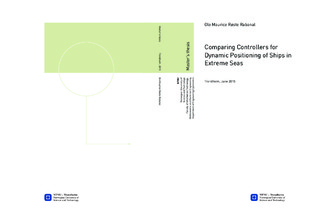| dc.description.abstract | The primary purpose of this study is to develop two different dynamic position-
ing (DP) controllers for a model-scale supply vessel Cybership III, and determine
which control strategy provides a safer, smarter and greener control when the ves-
sel is exposed to extreme seas. DP has since the 1960s contributed to the safety
and efficiency of oil-related and other operations for marine vessels. With this
computer-controlled system, vessels such as research vessels, supply vessels and
cruise ships can automatically maintain position and heading by using propellers
when the vessel is exposed to wind, waves and current.
A nonlinear passive observer (NPO), proportional-integral-derivative with acceler-
ation feedback (PID-AFB) controller, sliding-mode control (SMC) and a reference
model for Cybership III were derived. Test cases were first performed with the
Marine Cybernetics Simulator (MCSim) in calm, harsh and extreme seas. This
simulator consists of a high fidelity process plant model of Cybership III in Mat-
lab/Simulink together with models for generation of environmental forces. Sec-
ondly, tests in calm and harsh seas were performed on the model vessel in the
Marine Cybernetics Laboratory (MCLab) at MARINTEK. The performance for
tests in MCSim was evaluated by integral squared error (ISE), integral absolute
error (IAE) and integral time-weighted absolute error (ITAE). The measures of
performance for tests in the MCLab were performed by using ISE, IAE and ITAE
in combination with the energy consumption of the thrusters on Cybership III in
order to generate a cost function. This cost function is a new method used to eval-
uate the performance of the controllers with the aim of achieving a safer operation
meaning good accuracy, a greener operation by minimizing energy consumption and
a smarter operation by achieving the two latter simultaneously. Other measures
of performance used to evaluate controllers on Cybership III and similar vessels
in MCLab have as far as the knowledge of the author, only been performed with
respect to the error of the positions and heading. This thesis uses a new measure of
performance not only evaluating the error, but also the energy consumption during
tests, thus evaluating the controller with more realistic performance measures of
performance.
The PID-AFB-controller provided the best performance when the vessel was tested
in extreme seas in MCSim and was evaluated only by ISE, IAE and ITAE, while
the SMC achieved the best performance when tested in calm and harsh seas both
in the MCLab and MCSim. The tests performed in MCSim were not comparable
with the tests performed in the MCLab and the reasons for this may be inaccurate
model parameters, the lack of a proper thruster model, 3D effects of the waves
in the basin and reflection on the tank wall. In retrospect of the experiments,
Cybership III was found to weight 14% more than modeled in MCSim and hence the test cases in MCLab was considered to be more credible. | |

